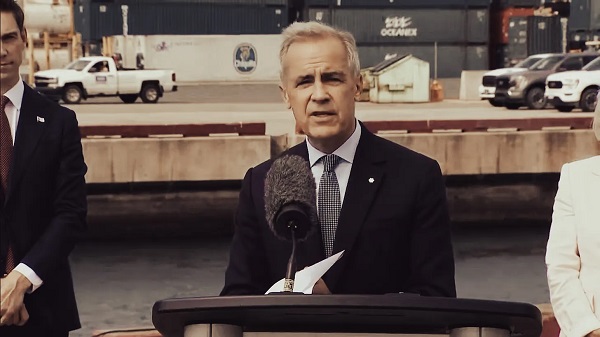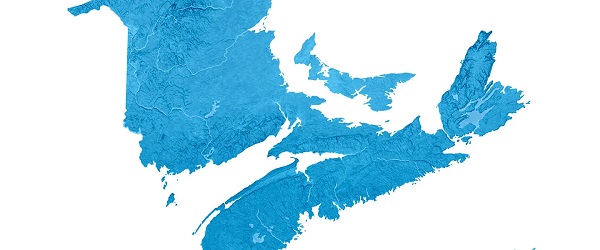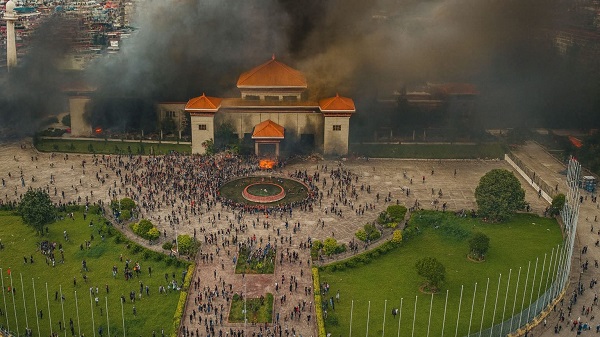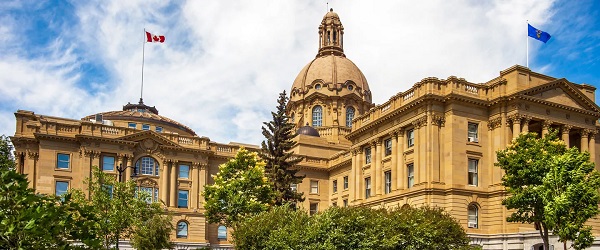Alberta
Alberta deserves a police force that actually reflects its values

This article supplied by Troy Media.
The RCMP answers to Ottawa, not Albertans. A provincial police force is the only solution
The recent comments from RCMP Staff Sergeant Camille Habel, who decried traditional values as a path to extremism, should be fuel for every Albertan committed to building a provincial police force that truly reflects our values, not Ottawa’s vision of what we should become.
Habel’s statement, framing beliefs rooted in community and local culture as potentially dangerous, highlights a growing disconnect between
the RCMP and the values that Albertans hold dear. This underscores the urgent need for a police force that is accountable to our province and its distinct way of life.
Alberta has witnessed troubling patterns of RCMP overreach—from door-kicking in Fort McMurray to aggressive tactics during the 2013 floods in High River to politically charged allegations against the Coutts Four. These aren’t isolated incidents but symptoms of an institution that has become increasingly disconnected from Alberta’s unique needs. The RCMP, which answers to Ottawa rather than the provincial government, has strayed from the values it was once founded to protect.
The RCMP wasn’t always like this. Originally a force with deep Western roots, it was created to maintain peace in a vast and rugged frontier. Today, however, the RCMP is centralist, politicized, and increasingly at odds with the values it once upheld.
This is why creating an Alberta Provincial Police (APP) isn’t just symbolic. It’s a constitutional right under Section 92 of the Constitution Act,
1867, already exercised by Quebec and Ontario. Alberta can—and should—do the same. A provincial police force would be accountable to the province, reflect local values, and serve Albertans’ unique needs rather than those of Ottawa.
But we must be clear: geography alone won’t solve the problem. If the new force carries the same institutional DNA as the RCMP, it will still lack the local understanding and trust that Albertans deserve.
The case of Jeremia and Dominic Leussink five years ago shows what’s at stake. The brothers, farmers near Didsbury, were going about their business when 18-year-old Jeremia, after a 16-hour shift, drove a tractor through a ditch into a police checkstop—normal in rural practice. The Alberta Sheriffs didn’t show restraint. They dragged him from the tractor, slammed him to the ground, and punched him in the neck and face. Dominic, who arrived later, was arrested trying to protect the equipment. The charges were eventually dropped but not before severe damage was done.
Alberta is not a generic province. Our motto, “strong and free,” is more than branding. We value private property as the cornerstone of liberty, and we cherish freedoms—of speech, worship, association, and dissent. These values are essential to life in this province, not ornamental. In contrast, the Canadian Charter of Rights and Freedoms omits property rights, reflecting a more centralized, Laurentian worldview. This ideological divide between Alberta and the federal government underscores the need for a police force that aligns with our values.
Habel’s remarks, labelling “traditional values” as a path to extremism, are not fringe—they reflect the growing establishment perspective. This shift directly impacts policing in Alberta, creating an urgent need for reform.
To chart a different course, Alberta’s police force must be trained differently. It must instill core virtues at the ground level.
First, Alberta’s police force must consist of officers who not only patrol the land but belong to it. Second, training must focus on independent judgment, not rote compliance. Third, the force must pursue real crime, not ideological ghosts. Fourth, it must be accountable to Albertans, not bureaucratic fads or external frameworks. Finally, it must protect Alberta’s culture: our commitment to freedom, property rights, and a government that serves, rather than rules, its citizens.
Alberta cannot afford to send officers to federal academies that instill a diluted worldview. A curriculum rooted in Alberta’s culture and history is essential. It will form the foundation of a legitimate provincial force. The Ministry of Public Safety must prioritize establishing the right institutional DNA.
We aren’t alone in facing these challenges. The Texas Rangers, though not perfect, offer a valuable comparison. Historically, they were embedded in the culture they served, answering to Texans, not federal fashions. Their authority came from the land upward, not from bureaucratic command downward.
Their ethos, captured in the saying “One riot, one Ranger,” was about competence, courage, and direct accountability—not swagger. They didn’t just enforce the law; they protected a way of life because they were part of it.
That’s the institutional culture Alberta must create: one where policing defends community, liberty, and order—not a tool of political engineering designed elsewhere. We need a police force that serves Alberta first, not a bureaucracy in a new uniform.
If done right, the Alberta Provincial Police will serve as a shield against federal overreach, cultural drift, and the creeping conformism of federal institutions. If done poorly, it will be the modern RCMP in a fresh uniform—still top-down, still alien, still suspect.
Alberta cannot afford to get this wrong. This is our moment to define a police force that works for us—rooted in our values and accountable to our people. Anything less would be a missed opportunity.
Marco Navarro-Genie is vice-president of research at the Frontier Centre for Public Policy and co-author, with Barry Cooper, of Canada’s COVID: The Story of a Pandemic Moral Panic (2023).
Troy Media empowers Canadian community news outlets by providing independent, insightful analysis and commentary. Our mission is to support local media in helping Canadians stay informed and engaged by delivering reliable content that strengthens community connections and deepens understanding across the country
Alberta
Provincial pension plan could boost retirement savings for Albertans

From the Fraser Institute
By Tegan Hill and Joel Emes
In 2026, Albertans may vote on whether or not to leave the Canada Pension Plan (CPP) for a provincial pension plan. While they should weigh the cost and benefits, one thing is clear—Albertans could boost their retirement savings under a provincial pension plan.
Compared to the rest of Canada, Alberta has relatively high rates of employment, higher average incomes and a younger population. Subsequently, Albertans collectively contribute more to the CPP than retirees in the province receive in total CPP payments.
Indeed, from 1981 to 2022 (the latest year of available data), Alberta workers paid 14.4 per cent (annually, on average) of total CPP contributions (typically from their paycheques) while retirees in the province received 10.0 per cent of the payments. That’s a net contribution of $53.6 billion from Albertans over the period.
Alberta’s demographic and income advantages also mean that if the province left the CPP, Albertans could pay lower contribution rates while still receiving the same retirement benefits under a provincial pension plan (in fact, the CPP Act requires that to leave CPP, a province must provide a comparable plan with comparable benefits). This would mean Albertans keep more of their money, which they can use to boost their private retirement savings (e.g. RRSPs or TFSAs).
According to one estimate, Albertans’ contribution rate could fall from 9.9 per cent (the current base CPP rate) to 5.85 per cent under a provincial pension plan. Under this scenario, a typical Albertan earning the median income ($50,000 in 2025) and contributing since age 18, would save $50,023 over their lifetime from paying a lower rate under provincial pension plan. Thanks to the power of compound interest, with a 7.1 per cent (average) nominal rate of return (based on a balanced portfolio of investments), those savings could grow to nearly $190,000 over the same worker’s lifetime.
Pair that amount with what you’d receive from the new provincial pension plan ($265,000) and you’d have $455,000 in retirement income (pre-tax)—nearly 72 per cent more than under the CPP alone.
To be clear, exactly how much you’d save depends on the specific contribution rate for the new provincial pension plan. We use 5.85 per cent in the above scenario, but estimates vary. But even if we assume a higher contribution rate, Albertan’s could still receive more in retirement with the provincial pension plan compared to the current CPP.
Consider the potential with a provincial pension contribution rate of 8.21 per cent. A typical Albertan, contributing since age 18, would generate $330,000 in pre-tax retirement income from the new provincial pension plan plus their private savings, which is nearly one quarter larger than they’d receive from the CPP alone (again, $265,000).
Albertans should consider the full costs and benefits of a provincial pension plan, but it’s clearly Albertans could benefit from higher retirement income due to increased private savings.
Alberta
OPEC+ chooses market share over stability, and Canada will pay

This article supplied by Troy Media.
OPEC+ output hike could sink prices, blow an even bigger hole in Alberta’s budget and drag Canada’s economy down with it
OPEC and its allies are flooding the global oil market again, betting that regaining lost market share is worth the risk of triggering a price collapse.
On Sept. 7, eight of its leading members agreed to boost production by 137,000 barrels per day beginning in October. That move, taken more than a year ahead of schedule, marks the start of a second major unwind of previous output cuts, even as warnings of a supply glut grow. OPEC+, a coalition led by Saudi Arabia and Russia, coordinates oil production targets in an effort to influence global pricing.
This isn’t oil politics in a vacuum. It’s a direct blow to Alberta’s finances, and a growing threat to Canada’s economic stability.
Canada’s broader economy depends heavily on a strong oil and gas sector, but no province is more directly reliant on resource royalties than Alberta, where oil revenues fund everything from hospitals to schools.
The province is already forecasting a $6.5-billion deficit by spring. A further slide in oil prices would deepen that gap, threatening everything from vital programs to jobs. Every drop in the benchmark West Texas Intermediate price, currently averaging around US$64, is estimated to wipe out another $750 million in annual revenue.
When Alberta’s finances falter, the ripple effects spread across the country. Equalization transfers from Ottawa to have-not provinces decline. Private investment dries up. Energy-sector jobs vanish not just in Alberta, but in supplier and service industries nationwide. Even the Canadian dollar takes a hit, reflecting reduced confidence in one of the country’s key economic engines. When Alberta stumbles, Canada’s broader economic momentum slows with it.
The timing couldn’t be crueller. October marks the end of the summer driving season, typically a lull for fuel demand. Yet extra supply is about to hit a market already leaning bearish. Oil prices have dropped roughly 15 per cent this year; Brent crude is treading just above US$65, still well beneath April’s lows.
But OPEC+ isn’t alone in raising the taps. Non-OPEC producers in Brazil, Canada, Guyana and Norway are all increasing production. The International Energy Agency warns global supply could exceed demand by as much as 500,000 barrels per day.
The market is bracing for a sustained price war. Alberta is staring down the barrel.
OPEC+ claims it’s playing the long game to reclaim market share. But gambling on long-term gains at the cost of short-term pain is reckless, especially for Alberta. The province faces immediate financial consequences: revenue losses, tougher budget decisions and diminished policy flexibility.
To make matters worse, U.S. forecasts are underwhelming, with an unexpected 2.4-million-barrel build in inventories. U.S. production remains at record highs above 13.5 million barrels per day, and refinery margins are shrinking. The signal is clear: demand isn’t coming back fast enough to absorb growing supply.
OPEC+ may think it’s posturing strategically. But for Canada, starting with Alberta, the fallout is real and immediate. It’s not just a market turn. It’s a warning blast. And the consequences? Jobs lost, public services cut and fiscal strain for months ahead.
Canada can’t direct OPEC. But it can brace for the fallout—and plan accordingly.
Toronto-based Rashid Husain Syed is a highly regarded analyst specializing in energy and politics, particularly in the Middle East. In addition to his contributions to local and international newspapers, Rashid frequently lends his expertise as a speaker at global conferences. Organizations such as the Department of Energy in Washington and the International Energy Agency in Paris have sought his insights on global energy matters.
Troy Media empowers Canadian community news outlets by providing independent, insightful analysis and commentary. Our mission is to support local media in helping Canadians stay informed and engaged by delivering reliable content that strengthens community connections and deepens understanding across the country
-

 Business2 days ago
Business2 days agoMark Carney’s Climate Competitiveness Pitch Falls Flat
-

 Business2 days ago
Business2 days agoCanada Post is broken beyond repair
-

 Alberta2 days ago
Alberta2 days agoMaritime provinces can enact policies to reduce reliance on Alberta… ehem.. Ottawa
-

 Business2 days ago
Business2 days agoCanada can’t allow so many people to say ‘no’ to energy projects
-

 International1 day ago
International1 day agoNepal Tried To Censor The Internet. Young People Set Parliament on Fire.
-

 Crime2 days ago
Crime2 days agoCharlotte train killer hit with federal murder charge, faces max penalty
-

 Alberta2 days ago
Alberta2 days agoYes Alberta has a spending problem. But it has solutions too
-

 Business1 day ago
Business1 day agoHealth-care costs for typical Canadian family will reach over $19,000 this year










